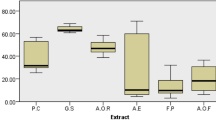Abstract
The effects of seven plants with suspected application to prevent and treat stone kidney formation (Verbena officinalis, Lithospermum officinale, Taraxacum officinale, Equisetum arvense. Arctostaphylos uva-ursi, Arctium lappa andSilene saxifraga) have been studied using female Wistar rats. Variations of the main urolithiasis risk factors (citraturia, calciuria, phosphaturia, pH and diuresis) have been evaluated. It can be concluded that beneficial effects caused by these herb infusions on urolithiasis can be attributed to some disinfectant action, and tentatively to the presence of saponins. Specifically, some solvent action can be postulated with respect to uric stones or heterogeneous uric nucleus, due to the basifying capacity of some herb infusions. Nevertheless, for all the mentioned beneficial effects, more effective and equally innocuous substances are well known.
Similar content being viewed by others
References
Grases, F., Conte, A.: Urolithiasis, inhibitors and promoters.Urol. Res., 20, 86 (1992).
Grases, F., Costa-Bauzá, A., March, J. G., Masárová, L.: Glycosaminoglycans, uric acid and calcium oxalate urolithiasis.Urol. Res., 19, 375 (1991).
Garcia-Raja, A., Conte, A., Grases, F.: The origin and causes of struvite stones.Int. Urol. Nephrol., 23, 537 (1991).
Lerner, S. P., Gleeson, M. J., Griffith, D. P.: Infection stones.J. Urol., 141, 753 (1989).
Sadi, M. V., Saltzman, N., Feria, G., Gittes, R. F.: Experimental observations on dissolution of uric acid calculi.J. Urol., 134, 575 (1985).
Brown, W. E., Gregory, T. M., Furedi-Milhofer, H. J.: Computed phase diagrams for the system: sodium hydroxide-uric acid-hydrochloric acid-water.J. Crystal Growth, 83, 588 (1987).
Font, P.: Plantas Medicinales, el Dioscórides renovado, Labor, Barcelona, Spain 1983.
Volák, J., Stodola, J., Servera, F.: Plantas Medicinales. Artia, Prague 1983.
Marozenco, Z.: Spectrophotometric Determinations of Elements. John Wiley & Sons, New York 1976.
Pesce, A. J., Kaplan, L. A.: Methods in Clinical Chemistry, C. V. Mosby, St. Louis 1987.
Grases, F., March, J. G., Ramis, M., Costa-Bauzá, A.: The influence of Zea mays on urinary risk factors for kidney stones in rats.Phytotherapy Res., 7, 146 (1993).
Grases, F., Masárová, L., Costa-Bauzá, A., March, J. G., Prieto, R., Tur, A.: Effect of Rosa canina infusion and magnesium on the urinary risk factors of calcium oxalate urolithiasis.Planta Medica, 58, 509 (1992).
Author information
Authors and Affiliations
Rights and permissions
About this article
Cite this article
Grases, F., Melero, G., Costa-Bauzá, A. et al. Urolithiasis and phytotherapy. International Urology and Nephrology 26, 507–511 (1994). https://doi.org/10.1007/BF02767650
Accepted:
Issue Date:
DOI: https://doi.org/10.1007/BF02767650




